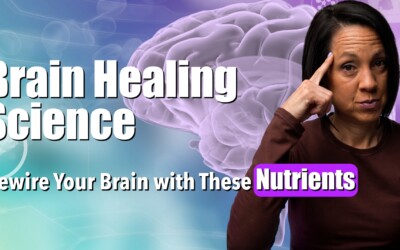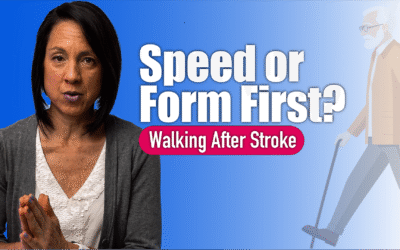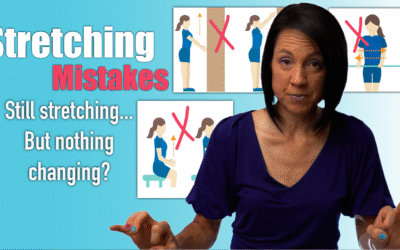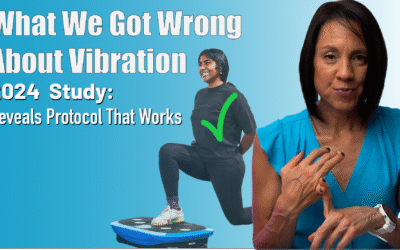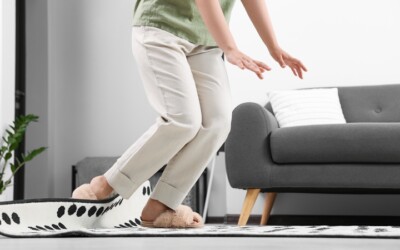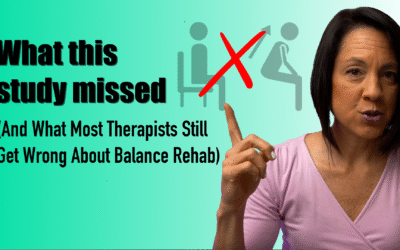Have you ever felt like your balance is fine at home… but the moment you step outside, it’s a totally different story? You’re not alone—and there’s a good reason for that.
I talk to a lot of people who say, “I feel pretty confident walking around my house, but the second I go to the grocery store or walk outside, I feel like I have no balance at all.” And even worse—many start avoiding those situations entirely.
If that’s you, let’s change that. Today we’re talking about the three most common balance training mistakes that might be holding you back from regaining confidence in the rea
Why Balance Progress Slows Down
Mistake #1: Only Practicing Static Balance
Let me guess—your balance routine looks a little something like this:
-
Standing with feet shoulder-width apart
-
Then feet together
-
Then near-tandem…
-
Then tandem (heel-to-toe)
-
And trying to hold each one for as long as you can
Sound familiar?
If so, you’re not doing anything “wrong.” These static balance exercises are great for early recovery or building foundational control. But here’s the deal: life doesn’t happen standing still.
Think about the last time you felt unsteady—or even had a near fall. Were you just standing still? Probably not. You were likely:
-
Reaching into a cabinet
-
Stepping over a curb
-
Turning quickly to look at someone
-
Backing up to open a door
These are all dynamic movements. So if you’re only practicing standing still, you’re not training your brain to respond to the real-life scenarios that actually challenge your balance.
What to Do Instead
You need to challenge what we call your limits of stability—how far your center of mass (your trunk) can move before you’re at risk of falling. Your balance improves when your body learns how to quickly and automatically recover when you’re near that edge.
A few ways to do that:
-
Reaching activities – Set objects just outside your comfort zone and reach for them
-
Move your feet – Instead of stepping into tandem stance with help, try doing it without holding on
-
Dynamic drills – Practice curtsy squats, crossover steps, and turn steps (especially helpful—stand in a corner and practice 360-degree turns both directions)
These activities teach your brain and body to react automatically using your legs (not your hands!) to recover balance. This is the kind of training that translates to navigating that busy store or uneven sidewalk.
Mistake #2: Not Challenging Your Sensory Systems
Balance isn’t just about strength. It’s about sensory input—the information your brain uses to figure out where your body is in space.
Here are the three big systems involved:
- Vision – Your eyes give you reference points to stay oriented (especially indoors with walls around)
- Vestibular system – Located in your inner ear, it senses head movements and sends that info to your brain
- Proprioception – Sensory input from your muscles, joints, and feet that tells your brain about body position and movement
The problem? As we age (or after a neurologic injury), we often rely too much on vision and stop using the others. So when you’re in the dark, close your eyes, or turn your head—your balance system crashes.
How to Strengthen These Systems
One of the best things you can do—whether you’ve had a stroke or not—is visual deprivation (aka: safely closing your eyes during exercises).
Here’s how to progress safely:
-
Start with your regular standing balance routine… but do it with your eyes closed
-
Try it in a corner (so you have a safety net)
-
Then, move on to stepping with eyes closed (forward/backward)
-
Once you’re confident, stand on a soft surface (like a pillow or couch cushion)
You can also try walking with head turns, which challenges your vestibular system. This one is actually part of a standardized fall-risk test! Can you walk in a straight line while turning your head side to side? If not, that’s something to work on.
Mistake #3: Not Practicing Enough (Especially in Daily Life)
Now this one’s a little different. I’m not just talking about doing “more therapy.”
I mean finding the opportunities in your everyday routine to challenge your balance. For example:
-
When you walk to the bathroom, resist the urge to furniture-walk
-
When turning to talk to someone, try not to automatically reach for something
-
Start letting go of those “safe spots” (the back of the couch, the door frame) once in a while—intentionally and safely
Why? Because the second you stop holding on, your brain has to work harder. It shifts from a passive activity (where your hands do the work) to an active one (where your balance systems are truly engaged).
This is when neuroplasticity kicks in. That’s how your brain learns. So whether you’re a stroke survivor or a caregiver, remember: the more actively engaged the brain is, the more progress you’ll see.
In Summary: The 3 Biggest Balance Training Mistakes
- Only doing static standing balance – You’re not preparing your body for real-life dynamic situations
- Not challenging your sensory systems – Especially if you rely heavily on vision
- Missing daily opportunities to challenge your balance – Passive walking won’t build confidence, but intentional practice will
I hope this gave you some new insight into why you might feel stuck—and what to do about it. The goal is always the same: restore your confidence so you can get back to living life fully. That means walking through the grocery store, wandering a farmer’s market, or just feeling secure outside your home.
If you found this helpful, be sure to download the free PDF handout linked below. It’s a great companion to this blog and will help you start applying what you’ve learned right away.
This file is for members only. Join now to access it.
Articles you may be interested in
Best Foods for Brain Healing and Mental Clarity
Brain Recovery Nutrition How Diet Fuels Healing and Focus https://youtu.be/P5UJMJJRVdw When it comes to stroke recovery, exercise and rehab often take the spotlight. But what if the foods you eat and the nutrients inside them could also play a powerful role in healing...
Is Your Neuro Rehab Helping Your Recovery, or Making Things Worse?
The Real Impact of Neuro Rehab on Recovery https://youtu.be/YDgQc4p_atE Recovering after a stroke often involves long hours of rehabilitation. Neuro rehab programs are designed to retrain the brain and body, helping survivors regain independence. Understanding...
How Short Bursts of Exercise Boost Brain Healing
HIIT for Stroke Recovery Boost brain rewiring, improve movement, and speed recovery with short bursts of exercise. https://youtu.be/4SgXN2uRX8g If you’ve been on your stroke recovery journey for a while, you’ve probably heard the word neuroplasticity. Neuroplasticity...
Stretching Spastic Muscles: 8 Mistakes to Avoid
8 Common Stretching Mistakes in Stroke Recovery Why Your Stretching Might Be Making Spasticity Worse https://youtu.be/bBsM34HROYY If you’re dealing with spasticity after a neurologic injury, stretching might not be as straightforward as it seems. In fact, doing it the...
New Study: Vibration Plates Boost Balance After Stroke
It Just Vibrates… So Why Are Stroke Survivors Getting Better? The Truth Behind the Research https://youtu.be/GZgGsMjEgJQ When vibration plates first became popular, they reminded many of us of those old 1980s machines that promised to "shake" the fat away. Naturally,...
Walking “Tips” that Sabotage Post-Stroke Progress
Recovering from Stroke? Don’t Let These 7 Walking Mistakes Set You Back Better Walking Starts by Avoiding These Mistakes https://youtu.be/_nkjHLdOeLc Recovering your walking ability after a stroke is an incredible accomplishment. You’ve put in the work. Strengthening...
The Hidden Reason Your Walking Feels Off After Stroke Rehab
The Missing Link in Stroke Rehab: Why Strength Isn’t Enough How Plyometric Exercises Can Improve Your Post-Stroke Walking https://youtu.be/0xzcgTifCiM Recovering from a stroke is a journey that takes patience, effort, and persistence. Maybe you’ve been faithfully...
Struggling with Shoulder Pain After a Stroke? Here’s What Works
Why Does My Shoulder Hurt After a Stroke?Understanding the 6 Most Common Causes and What You Can Actually Do About Them Let’s be real — if you’re recovering from a stroke and your shoulder still hurts, it can feel really defeating. Especially if you’ve been doing “all...
Still Feeling Weak After Stroke? This Might Be Why
Doing the exercises… but still not getting stronger?You’re walking. You’re moving. Maybe even getting stronger.But everything still feels hard. Like walking across a room takes full concentration. Or standing up while talking feels like solving rocket science....
Stroke Recovery: Spasticity vs. Adaptive Shortening vs. Contracture
Stroke Recovery: Spasticity vs. Adaptive Shortening vs. Contracture Muscle tightness after stroke is common and can be the greatest barrier to restoring normal arm and leg movement. But not all tightness is the same. To treat it effectively, you need to understand...


